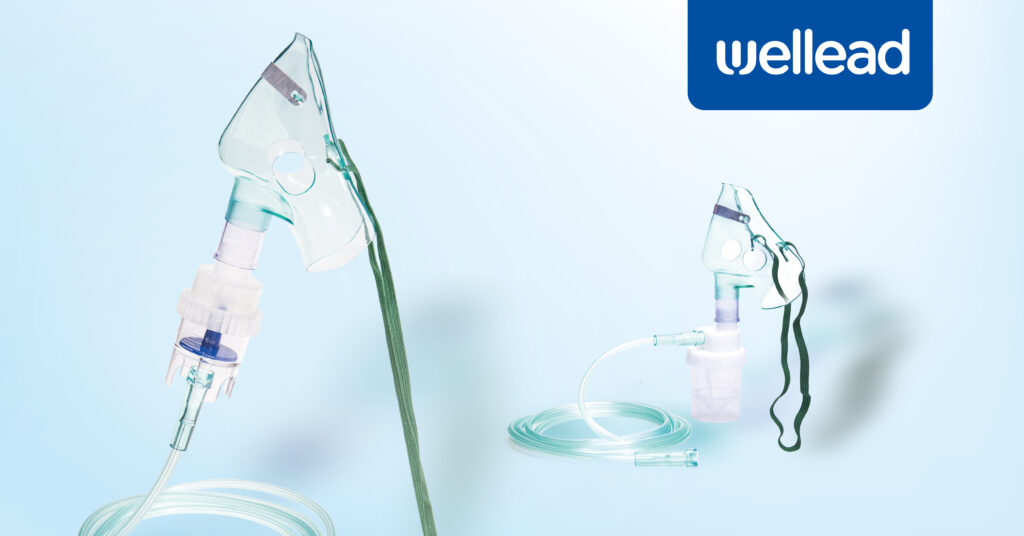Nebulizers are indispensable for deep lung medicine delivery when treating respiratory disorders. Among nebulizer accessories, the nebulizer mask optimizes aerosol delivery and patient comfort. Why nebulizer mask has holes? In particular, these masks’ perforations function as exhalation apertures. They help circumvent CO2 accumulation and maximize airflow. Furthermore, they also improve patient safety with regulated pressure and ventilation. Meanwhile, this article explains how the parts of nebulizer mask systems work to provide successful treatment.

Key Parts of Nebulizer Mask Set and Their Functions
1. Aerosol Mask
The aerosol mask is the interface that delivers aerosolized medication to the respiratory system, secured in place with an elastic strap. It confirms close contact with the nose and mouth. Adjustable straps provide better fit and patient comfort. For performance, it must fit since gaps affect efficiency. E.g., pediatric masks may have designs to keep comfort and adherence to therapy. Verify that the mask’s material is hypoallergenic and medical-grade to avoid irritation. The elastic strap material should also be durable and soft to avoid skin pressure sores during prolonged treatments.
2. Reservoir Cup (Medication Chamber)
The reservoir cup, or medication chamber, holds the liquid medication before aerosolization. It facilitates consistent particle size production within 1-5 microns. It is ideal for deep lung penetration. Its geometry and material impact drug delivery efficiency. Some high-performance reservoir cups have anti-static properties for lower medication adhesion to the chamber walls.
3. Oxygen Tubing
The oxygen tubing connects the nebulizer machine to the reservoir cup. It carries compressed air or oxygen. It must have low resistance and high flexibility for pressure transmission. Tubing length can influence medication delivery rates. For instance, longer tubing may decrease airflow velocity and alter treatment efficacy. Inspect for kinks or blockages; it can interrupt therapy.
4. Air Compressor
The air compressor compresses air to aerosolize liquid medication in the reservoir cup. Devices use piston-driven or diaphragm compressors for steady pressure, say 6-8 L/min, for optimal nebulization. Unconventional models may include flow regulators to customize aerosol output per patient needs. Maintenance guarantees dependable performance.
5. Exhalation Valves
Additionally, some nebulizer masks may also be equipped with exhalation valves. The valves are primarily used in certain specific nebulizer designs to reduce medication waste and enhance therapeutic efficacy. The exhalation valves direct exhaled air out of the mask. They prevent carbon dioxide from rebreathing. Their unidirectional design warrants that only fresh, aerosolized medication enters the respiratory tract.
Along these lines, healthcare professionals might give accurate, efficient patient-specific treatments while comprehending such parts of nebulizer mask systems.
The Function of Holes in Nebulizer Masks
- Drug delivery.
- Airflow management.
- Maintenance of pressure balance in the mask.
- Enhancement of comfort.
- Prevention of CO2 buildup.
- Facilitation of exhalation.
- Improved fit and seal.
- Decline of condensation inside the mask.
- Minimization of aerosol loss.
- Support for the finest nebulization performance.
FAQs about Nebulizer Masks
1. What Is The Difference Between A Nebulizer Mask And A Mouthpiece?
A nebulizer mask covers the nose and mouth for medication delivery through both airways. Yet, a mouthpiece directs medication through the mouth. Masks suit individuals with limited dexterity or inability to hold the device, including children or the elderly. Meanwhile, mouthpieces are more efficient with lower aerosol waste for patients with a focused breathing pattern. Both use the tubing and reservoir cup like a nebulizer mask system for performance.
2. Are Nebulizer Masks Suitable For Patients Of All Ages?
Yes, but they differ in design. Pediatric nebulizer masks are smaller and shaped to fit snugly for negligible leakage. Adult masks have larger chambers for higher lung capacities. Some patients with COPD benefit from mask options due to their diminished breathing strength. Alterations to the parts of nebulizer masks, like using softer edges, can also stop pressure sores on the skin.
3. What Position Should A Patient Be In When Using A Nebulizer Mask?
Ideally, patients should sit upright during nebulization mask use. It helps the diaphragm expand fully for medication absorption. For bedbound individuals, a semi-reclined position is okay. Higher tilt may risk pooling medication within the reservoir cup for less aerosol efficiency. Well Lead Medical’s Nebulizer with Aerosol Mask incorporates a rotatable joint between the reservoir cup and the mask, allowing the cup to maintain a vertical position without tilting. However, the orientation of the parts of nebulizer masks should be unobstructed to avert airflow disruption.
4. Can Nebulizer Masks Cause Choking?
Usage can rarely cause choking sensations. Overfilled medication cups or undue flow rates may overwhelm the patient’s airway. Masks should always fit without blocking natural airflow. In sensitive post-surgical respiratory patients, lighter aerosol settings and closer monitoring soften risks. Adjusting the airflow and inspecting all nebulizer parts of the mask for blockages is key.
5. Can Nebulizer Masks Cause Dryness In The Mouth?
Yes, prolonged use may cause dryness. Aerosolized medications, like bronchodilators, can decrease saliva production. Isotonic saline in the reservoir cup may cut this issue. Guaranteeing humidification within the system while checking the parts of nebulizer masks for leaks or incorrect seals helps keep moisture levels. Hydrating post-treatment also curtails distress.
Nebulizer with Aerosol Mask from Well Lead Medical
Well Lead Medical precision-engineers Nebulizer with Aerosol Mask for respiratory treatment.
The nebulizer mask has a nebulization rate ≥0.2 ml/min, a nebulized particle size ≤5 μm, and a driving gas flow rate of approximately 4 to 8 L/min.
An adjustable nose clip and elastic strap provide a snug fit and aerosol distribution in our nebulizer masks. We provide conventional and elongated designs in adult and pediatric sizes for wide-ranging patient demands. Our masks are DEHP-free and medical-grade for patient safety. Each mask works flawlessly with nebulizers for efficient medicine provision. We seek to increase treatment results and patient comfort while concentrating on the critical parts of nebulizer masks.

